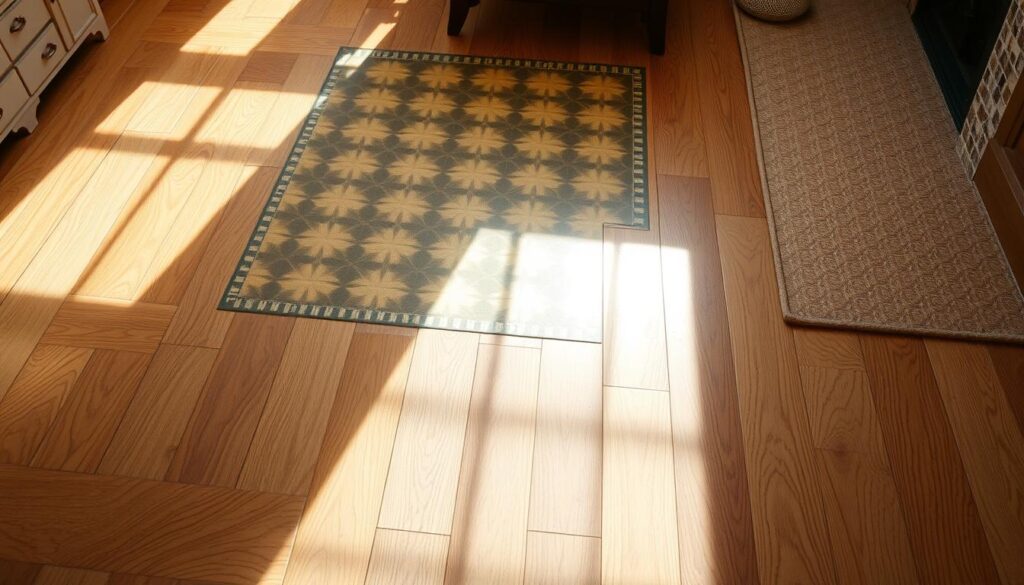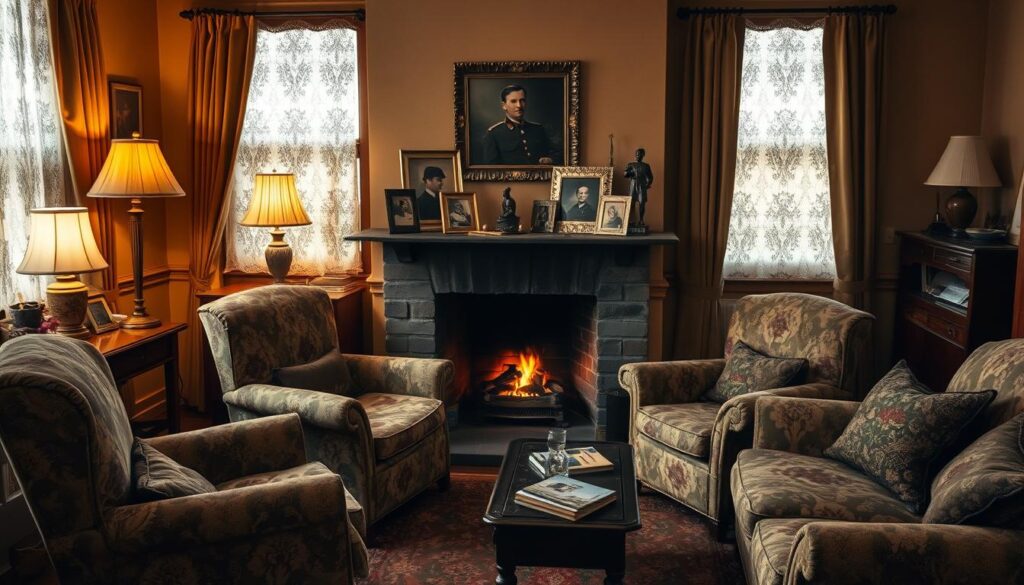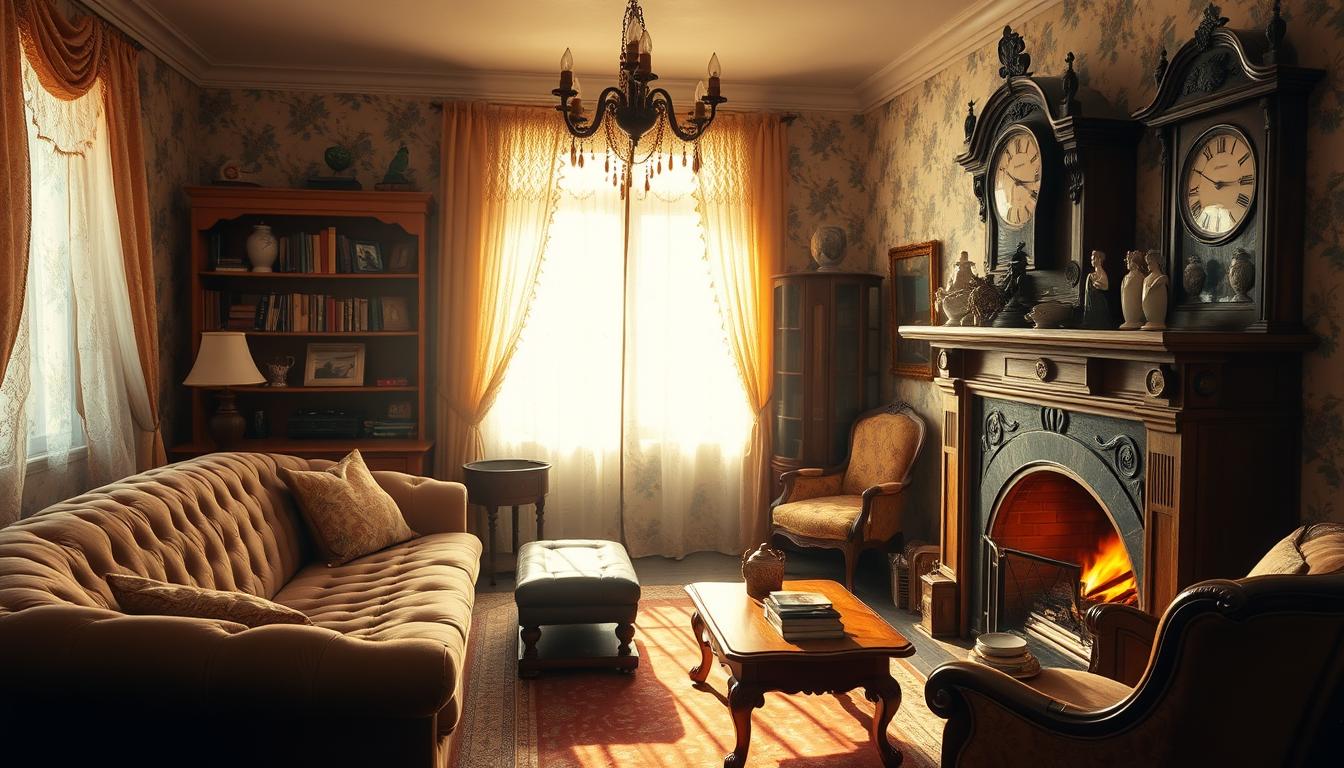The 1940s was a time of big change in vintage home decor. It was influenced by wartime needs and the rise of modernism. This guide will show you how the era mixed function with a touch of nostalgia.
We’ll look at what made 1940s home interiors special. This includes the colors, furniture, and cultural trends of the time. By learning about these, you can bring the 1940s vibe into your home.
Key Takeaways
- Understanding the cultural influences on 1940s design
- Identifying key furniture trends of the era
- Exploring popular color palettes of the 1940s
- Learning how to incorporate vintage elements into modern decor
- Recreating the nostalgic feel of 1940s home interiors
Overview of 1940s Home Interior Design
In the 1940s, homes showed the era’s tough times through design. They mixed function and patriotism. World War II made homes simple yet creative.
Key Characteristics of the 1940s Style
The 1940s style used what was available because of war shortages. This led to new ways in making furniture and decorating. Mid-century modern furnishings started, focusing on simplicity and usefulness.
Red, white, and blue were big in decor, showing patriotism. Retro design ideas were seen in bold colors and shapes in fabrics and wallpaper.
Influences Shaping 1940s Interiors
World War II changed interior design, making it more practical. People used local materials and new tech like plywood and plastics. This made furniture and decor different.
The war also changed family life, with women working more. Homes became more functional to fit these new family needs.
Color Palettes Popular in the 1940s
In the 1940s, homes were filled with earthy tones and soft pastels. This created a cozy and inviting space. The choice of colors was shaped by the cultural and economic times, including World War II.
Muted colors were big in the 1940s. They were not just pretty but also showed the resourcefulness of the time. People chose colors that were both durable and easy to care for.
Earthy Tones and Pastels
Colors like terracotta, sienna, and umber were popular for their warmth. They were often used in living rooms and dining areas to make them feel welcoming.
Soft pastels like pale pink, baby blue, and mint green were also popular. They were used in bedrooms and nurseries for their calming effect.
| Color Category | Popular Shades | Common Uses |
|---|---|---|
| Earthy Tones | Terracotta, Sienna, Umber | Living Rooms, Dining Areas |
| Soft Pastels | Pale Pink, Baby Blue, Mint Green | Bedrooms, Nurseries |
Accent Colors for a Distinct Look
Accent colors were key in adding a unique touch to rooms. Deep reds, rich greens, and vibrant yellows were used to highlight areas.
These colors were used in items like vases, throw pillows, and wall art. They added a splash of color and personality to any room.
“The use of accent colors can completely transform the look and feel of a room, adding depth and visual interest.” – Interior Design Expert
To bring the 1940s color palette into your home, use earthy tones and soft pastels as main colors. Add depth with deeper, richer shades.
Furniture Trends in the 1940s
In the 1940s, furniture design focused on being practical and durable. World War II had a big impact, making some materials hard to find. This led to furniture made from new and different materials.
Functional and Practical Designs
Furniture in the 1940s was all about being useful. Many pieces could do more than one thing to save space. For example, a coffee table could also hold things.
New materials and ways to make furniture appeared, like molded plywood and metal frames. This made furniture that was strong and could be used in many ways.
The need for practical furniture came from the war. With resources going to the war, makers had to get creative. This led to antique furniture styles that were simple, strong, and made with what was available.
Iconic Furniture Pieces from the Era
Some furniture from the 1940s is now famous. It shows the style of the time. These include:
- Armchairs with molded plywood frames
- Desks with metal accents
- Coffee tables with storage compartments
These pieces met the needs of the time but also had style. They are still loved today for their design.
| Furniture Piece | Characteristics | Materials Used |
|---|---|---|
| Molded Plywood Armchair | Curved design, ergonomic | Plywood, metal fasteners |
| Metal Accent Desk | Simple, durable, versatile | Wood, metal accents |
| Storage Coffee Table | Multi-functional, space-saving | Wood, metal hardware |
Design historians say the 1940s were a time of big change in furniture design. It was driven by need and creativity. “The furniture of the 1940s shows the era’s spirit of resilience and resourcefulness,” says a design expert.
“The furniture of the 1940s was not just functional; it was a testament to the ingenuity of designers and manufacturers who worked with limited resources to create pieces that were both beautiful and durable.”
Textiles and Patterns from the 1940s
The 1940s were a time of creative use of textiles in homes. Fabrics and patterns were key in adding warmth and style to rooms.
Fabric Choices and Their Uses
In the 1940s, people chose fabrics that were both practical and stylish. Cotton and linen were favorites for their durability and easy care. Rayon, a semi-synthetic fabric, was also popular for its silk-like feel and affordability.
For furniture, velvet and tapestry were top choices. They were used in living and dining rooms to make spaces cozy and inviting.
Popular Patterns and Prints
Patterns and prints were big in 1940s decor. Floral patterns were a hit, often seen in curtains and upholstery. Stripes and geometric patterns also made an appearance, bringing a modern vibe to rooms.
Historical motifs like toile de Jouy were used to add elegance. These designs often showed scenic views and historical scenes.
| Fabric Type | Common Use | Characteristics |
|---|---|---|
| Cotton | Draperies, Upholstery | Durable, Easy to Clean |
| Linen | Upholstery, Tablecloths | Breathable, Natural Texture |
| Rayon | Dresses, Curtains | Silk-like Texture, Affordable |
Interior designers of the time knew that the right fabric could change a room. They chose textiles for both function and beauty. This shows the resourcefulness and style of 1940s home decor.
“The use of vibrant patterns and diverse fabrics in 1940s interiors not only reflected the era’s aesthetic preferences but also its values of resourcefulness and practicality.”
Lighting Styles in 1940s Homes
Lighting in the 1940s was key in home design, blending function and style. The era’s lighting fixtures greatly influenced a room’s feel.
Types of Lighting Fixtures
The 1940s offered a range of lighting that was both stylish and practical. Table lamps and floor lamps were favorites, known for their detailed designs. These lamps lit up rooms and added to their beauty.
Ceiling lights, like flush mounts and chandeliers, were also popular. Flush mounts were great for small spaces because they lit up well without taking up much room.
The Role of Natural Light
Natural light was a big part of 1940s home design. Homes from this time often had large windows, letting in lots of natural light. This made rooms feel bigger and warmer.
Homeowners used windows and curtains to control the light. This helped create the perfect mood and function in their homes.
Flooring Options Common in the 1940s
The 1940s offered a variety of flooring choices for homeowners. These options were not just practical but also showed off the design trends of the time.
World War II affected material availability, leading to the use of alternative flooring. We’ll look at the popular options, like hardwood vs. linoleum flooring, and the role of area rugs and carpeting.
Hardwood vs. Linoleum Flooring
Hardwood flooring was still a favorite in the 1940s for its durability and classic look. Oak and maple were top choices, often laid out in traditional patterns. But, the wartime economy made linoleum a more affordable option.
Linoleum, made from natural materials, was both budget-friendly and versatile. It came in many patterns and colors, making it great for kitchens and bathrooms.
- Hardwood flooring offered durability and a classic look.
- Linoleum flooring was a cost-effective and versatile alternative.

Popular Area Rugs and Carpeting
Area rugs and carpeting were also key in 1940s home decor. They added warmth and comfort, and their designs matched the era’s trends.
Area rugs helped define spaces and added elegance. Carpeting, used in bedrooms and living areas, made rooms cozy. The designs included floral patterns to geometric motifs, fitting the 1940s interior style.
- Area rugs were used to define spaces and add elegance.
- Carpeting created a cozy atmosphere in bedrooms and living areas.
Knowing about 1940s flooring helps homeowners today choose vintage elements. Whether it’s hardwood, linoleum, or area rugs and carpeting, there are many ways to bring retro design into your home.
Kitchen Design in the 1940s
In the 1940s, kitchen design focused on both looks and function. This was due to the need for efficiency during wartime. Kitchens were made simple and practical, using what little resources were available.
Layouts and Functional Spaces
Kitchens of the 1940s were all about being useful. They were set up to make work easier, with a focus on moving less. The work triangle concept was used, even if it wasn’t called that back then. It helped keep the sink, stove, and fridge close together.
- Compact designs to save space and resources
- Efficient storage solutions, such as built-in cabinets and pantry organizers
- Multifunctional areas for food preparation and cooking
Color Schemes and Appliance Styles
The colors in 1940s kitchens were soft and natural. They used soft pastels and earth tones. Appliances were both useful and stylish, with designs that are now classic in mid-century modern homes.
Some key features of 1940s kitchen appliances include:
- Enamel-coated steel finishes in a range of colors
- Streamlined designs to fit the modernist aesthetic
- Emergence of new materials and technologies, such as stainless steel and electric appliances
To add a 1940s touch to your kitchen today, mix old and new. You could use retro-style appliances and choose traditional materials like hardwood for cabinets. Also, pick colors that were popular back then.
Impact of World War II on Home Interiors
World War II changed home interiors a lot. With less resources and rationing, people got creative. They found new ways to design their homes.

Resourcefulness in Design
Resourcefulness was key in home design during World War II. With materials hard to find, people used what they had. They repurposed fabrics and furniture.
People also went back to nostalgic home decorations. They kept items that reminded them of better times. This brought comfort during hard times.
| Material | Pre-War Use | Wartime Adaptation |
|---|---|---|
| Wood | Furniture making | Used for air raid shelters, furniture was often downsized or repurposed |
| Metal | Decorative fixtures, furniture frames | Recycled for war efforts; replaced with wood or other materials in home decor |
| Fabric | Upholstery, curtains | Repurposed for clothing, bandages; used sparingly in home decor |
Innovations Born from Necessity
World War II led to new ideas in home design. Antique furniture styles were made with new materials. This was because old materials were hard to find.
- Multifunctional furniture became popular, serving more than one purpose to save space and materials.
- Lighting fixtures were redesigned to use less material, and new materials like plastic became more common.
- The use of makeshift decorative items became a norm, with people crafting their own decorations from available materials.
These new ideas showed how creative people were during hard times. They changed home design forever.
Tips for Incorporating 1940s Style Today
To add 1940s charm to your home, mix old and new. This blend creates a unique, nostalgic feel. It respects the past while being modern.
Vintage Meets Modern
Mixing vintage and modern decor needs careful thought. Start by choosing real 1940s items, like furniture or accessories. Then, pair them with today’s decor for a balanced look.
For example, a vintage armchair can look great with a modern sofa. This contrast is striking.
Authenticity Matters
Finding true 1940s decor is key to capturing its spirit. Look in antique stores, flea markets, or online. This way, you can find original pieces or ones that look like they’re from the 1940s.
Adding these items gives your space depth and character.



